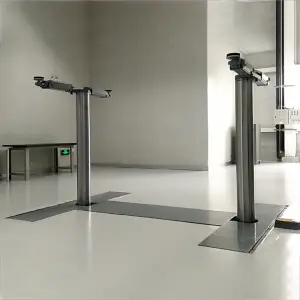****
The automotive industry is currently in the midst of a remarkable transformation, largely driven by the transition toward new energy vehicles (NEVs) that aim to reduce greenhouse gas emissions and reliance on fossil fuels. One critical aspect of this evolution is the technology surrounding NEV battery lifts, which plays a pivotal role in both the performance and convenience of electric vehicles (EVs) and hybrid electric vehicles (HEVs). In this article, we will delve into the significance of NEV battery lifts and how they contribute to the broader goals of sustainable mobility.

The Future of Transportation: Unveiling the Importance of New Energy Vehicle Battery Lift in Sustainable Mobility Solutions
At its core, the NEV battery lift system facilitates the efficient removal, replacement, and maintenance of the massive battery packs that power these vehicles. As electric batteries grow in size and complexity, the challenge associated with their handling has escalated. Traditional methods of battery installation and removal can be labor-intensive, time-consuming, and potentially hazardous. The development of advanced battery lift technology has transformed how manufacturers and service providers approach the battery servicing aspect of NEVs, ultimately enhancing the user experience and aiding in the widespread adoption of electric vehicles.
One of the most salient benefits of NEV battery lifts is the significant reduction in time and labor required for battery maintenance and replacement. In an industry where the efficiency of service operations can dictate a company’s success, the introduction of battery lift systems not only streamlines these processes but also ensures that technicians can handle heavy battery packs safely and effectively. This improved efficiency can reduce downtimes for fleet operators and private EV owners alike, making cost-effective maintenance more attainable and further encouraging the adoption of electric vehicles.
Moreover, NEV battery lifts are designed with safety in mind. As EV battery technology continues to evolve, battery packs are becoming more powerful and heavier, often weighing several hundred kilograms. Lifting heavy batteries can pose risks of injury to service personnel and damage to the vehicle itself. Battery lift systems are typically equipped with advanced safety mechanisms, such as load sensors, automatic braking systems, and ergonomic control panels, ensuring that the battery handling process is safer and user-friendly. Furthermore, these innovations provide an added layer of protection against short-circuiting and fire hazards, thereby making the transition to NEVs less daunting for both service providers and consumers.

The Future of Transportation: Unveiling the Importance of New Energy Vehicle Battery Lift in Sustainable Mobility Solutions

The Future of Transportation: Unveiling the Importance of New Energy Vehicle Battery Lift in Sustainable Mobility Solutions
In addition, NEV battery lifts contribute to sustainability beyond the energy aspect of vehicles. By allowing for the more efficient servicing and recycling of battery packs, these technologies can help reduce waste in the automotive industry. With the growing concern about the environmental impact of lithium-ion batteries, effective battery recycling has become increasingly crucial. Battery lifts can facilitate the collection and transportation of old or depleted batteries to recycling facilities, encouraging the circular economy within the automotive industry. The ability to reclaim valuable materials, such as lithium, cobalt, and nickel from used batteries, not only mitigates environmental impact but also assures a steady supply of essential resources for future battery production.
As electric vehicle adoption continues to surge globally, government policies and regulations increasingly mandate the reduction of emissions and the promotion of clean transportation alternatives. The role of NEV battery lifts will become increasingly vital in ensuring that service infrastructures can meet the anticipated surge in demand for battery maintenance and replacement. Manufacturers are already exploring innovative battery lift designs that are adaptive and scalable, which will be essential in accommodating a broad spectrum of electric and hybrid vehicles.
To conclude, as we transition towards a more electrified transportation future, the role of New Energy Vehicle Battery Lifts cannot be overlooked. These systems enhance operational efficiency, ensure technician safety, facilitate sustainable practices, and ease the service burden associated with heavier, complex battery systems. As technology continues to advance, we can anticipate even greater innovations in this arena, positioning battery lifts as indispensable tools in the ongoing effort to make electric mobility seamless, safe, and environmentally responsible. In a world increasingly focused on sustainability and reducing carbon footprints, NEV battery lifts represent not just a technological advancement, but a crucial constituent in the shift towards a greener, more sustainable automotive industry.quicklift car lift




